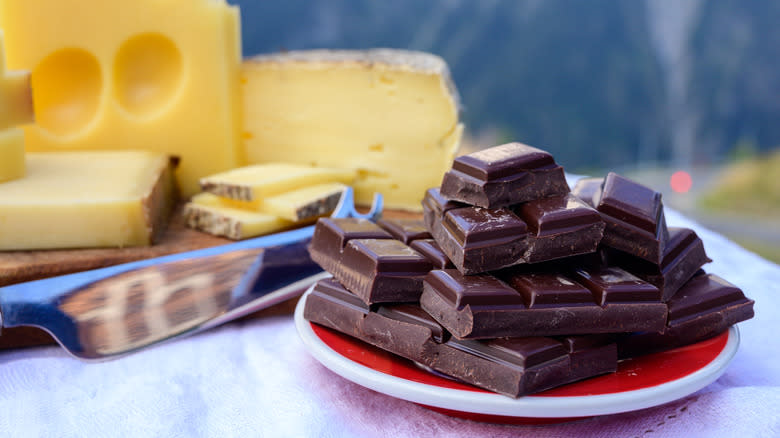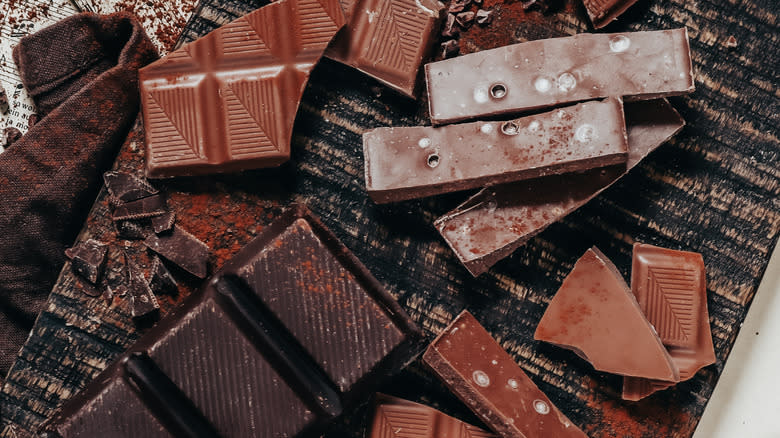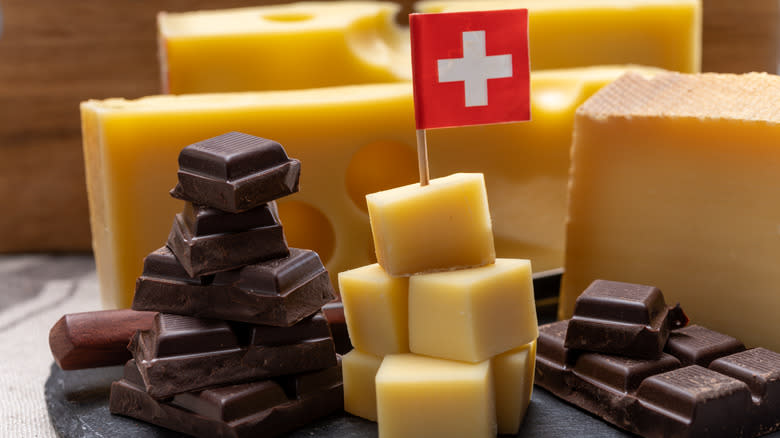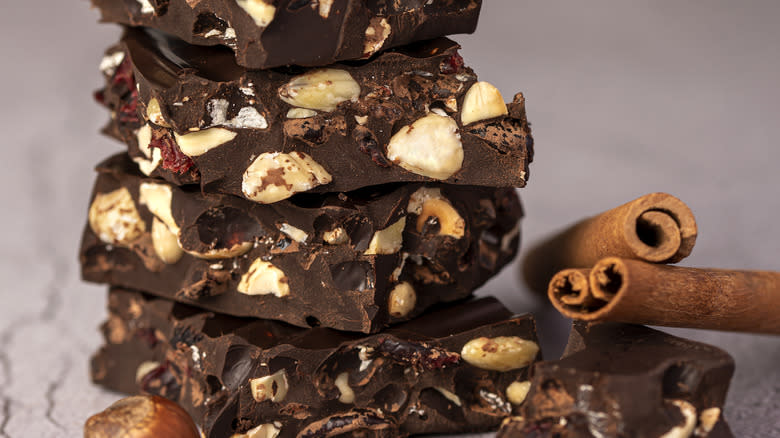The Best Cheese And Chocolate Pairings For Your Fanciest Charcuterie Board Yet

Charcuterie boards are the perfect appetizer for events and get-togethers, but if you're bored of cheese and meat, you don't have to pass up on these mouthwatering snack displays. Try making an exciting board featuring perfectly paired cheeses and chocolates. The key to success is thinking carefully about what items to pair together, in order to create balanced flavors that blend well in your mouth.
Matthew Rose, ACS CCP, CCSE, and partner at Fairfield and Greenwich Cheese Company, sat down with Daily Meal and provided some exclusive insights into how to really make chocolate and cheese pairings sing. He says that the type of cheese you pair with chocolate depends on how much cacao is in the bar. The mild and sweet flavors of milk chocolate can work well with milder cheeses. On the other hand, if it's dark chocolate you're dealing with, the intensity and layered flavor notes make it a prime candidate for stronger cheeses, such as an intense washed rind cheese or nutty alpine varieties.
If you're a fan of chocolate bars with caramel, fruit, nuts, or other inclusions, Rose says that "Chocolate with added flavors and other food items [...] can lend itself to a very interesting pairing experimentation". Instead of just focusing on the darkness of the chocolate, you'll likely have to experiment more to successfully balance all the elements.
Read more: 8 Chocolate Bars That Are Totally Different Outside The US
Pair Lower Cacao Chocolates With Milder Cheeses

Milk chocolate shouldn't be overlooked -- higher-cacao brands make delicious grown-up partners for cheese. Milk chocolates generally contain less than 50% cocoa solids (though inexpensive bars may have as little as 10%). Matthew Rose recommends a mild partner for this creamy confection: Tomme-style French cheeses. He notes that these products "tend to be only aged a few months and have a milder flavor profile [...] earthy and mushroomy, gently tangy, and even fruity." These complex tasting notes that come out against the backdrop of sweet chocolate. Rose recommends Tomme de Savoie from France or the American-made Swallow Tail Tomme from Stoney Pond Farm.
Moving away from standard milk chocolate bars, there's also slightly stronger dark milk chocolate. Sound confusing? These chocolates are merely on the darker side of milk, with a cacao percentage between 50% and 70%. They have all the creaminess of traditional milk chocolate, but a slightly more bitter, complex flavor.
For these darker milk bars, Rose recommends milder, gooey washed rind cheeses such as Taleggio. He explains that these soft or semi-soft cheeses are "washed with a salt water brine and have savory, toasty, and grassy flavors." Dark milk chocolate can stand up to these saltier notes, but Rose says he likes to pair tamer washed rind cheeses with standard milk bars, too.
With Dark Chocolate, Think Of Bold Or Balanced Cheeses

Dark chocolate is usually defined as containing 55% cocoa solids or more. Matthew Rose notes that its dry texture and more acidic, bitter flavors go well with alpine-style cheeses, ones that are "densely creamy with notes that are nutty, oniony/garlicky, and malty." He recommends Swiss Gruyere or Appenzeller.
While many dark bars hover around 70% cacao, you can also pick up chocolates containing up to 100%. If you're looking at these varieties, Rose suggests intense washed rind cheese pairings, saying, "The stronger washed rinds have more pungent, meaty flavors and more intense saltiness and makes them a good candidate for pairing with dark chocolates over 85%." For instance, a Vacherin Mont d'Or might be a good pick. This smelly cheese has a salty flavor and creamy consistency that balances out dark, dry, bitter chocolate.
Rose offers a few other bold suggestions for super dark chocolates: "Blue cheeses that tend to have notes of black pepper, licorice and eucalyptus (Bayley Hazen Blue from Jasper Hill in Vermont or English Stilton)", or "mature farmhouse cheddars (Pitchfork Cheddar from England or Shelburne Farms Cheddar from Vermont)." The stronger tastes of these cheeses can work against more astringent cacao notes, for a punchy flavor party in your mouth. If you're not into funky tastes, Rose says you can also tone down the harshness of dark chocolate. He suggests Brie-style cheeses that are double or triple crème cheese and "more milky than vegetal."
Experiment With Flavored Chocolates Cautiously

If you love chocolate with caramel, nuts, or other inclusions, Matthew Rose has a few words of caution. While you can certainly attempt pairings with cheese, you might not want to do so if you're inexperienced. "I do think chocolate is already very complex," he says, "and should be tried first with minimal added food elements for the consumer to understand better the relationship between cheese and chocolate." He adds that it's best to start with more simple chocolates and slowly work your way up from there, as you get more familiar with different textures and flavor combinations.
With that being said, if you really love dressed-up chocolates, Rose encourages you to go for it anyway. Think about the flavors that inclusions add to the chocolate and how it changes the tasting profile. With a nutty cheese, such as Gruyère, Rose says he wouldn't use chocolate with nuts, because they could compete with each other's subtle flavors. Might we suggest a fruity dark chocolate that contrasts with and emphasizes the rich, nutty cheese? For a complementary take, you could pair a creamy Wensleydale with chocolate that has toffee in it. Those crunchy, sweet bits can bring out the honey notes in the cheese and create a match made in heaven.
Read the original article on The Daily Meal


